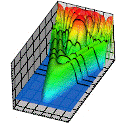Department of Physics and Astronomy: Publications and Other Research
Date of this Version
November 1989
Abstract
Detailed theoretical results are presented for the electron-detachment cross section, doubly differential in both the electron momentum and angle, for the process 0.5-MeV H-+He→H(n=2)+ e-+He*. As discussed briefly elsewhere [C. R. Liu and A. F. Starace, Phys. Rev. Lett. 62, 407 (1989)], the laboratory-frame doubly differential cross sections (DDCS’s) for electron detachment in the forward direction are shown to depend sensitively on the low-energy states of the H(n=2)- e- three-body system. In particular, the angular dependence of characteristic cusp and shape resonance features is presented. We find that the projectile frame DDCS for detached electron energies in the vicinity of the shape resonance peak is nearly isotropic. This is due in part to the 1P symmetry of the resonance feature, which limits the angular distribution to constant and cos2θ terms, and in part to cancellation in the integral over momentum transfer on which the coefficient of the cos2θ term depends. We also find that the rapid variation of these cusp and shape resonance features with angle in the laboratory frame requires that experimental angular and energy resolutions be accounted for in order to obtain good agreement with the measured results of M. G. Menendez and M. M. Duncan [Phys. Rev. A 36, 1653 (1987)] on the energy spectrum of detached electrons coincident with the formation of H(2p). The DDCS’s for 0.5-MeV H-+He→H(1s)+ e-+He* are also presented. When these latter results are added to those for producing H(n=2), the sum gives good agreement with the experimental data of M. G. Menendez and M. M. Duncan [Phys. Rev. 20, 2327 (1979)], which include all final states of the H atom, thereby confirming the important contribution the H(n=2) states make to the total-detachment cross section. We present evidence on the sensitivity of these results to the choice of the average excitation energy of the helium target. Finally, we pinpoint the origin of our predicted Gailitis-Damburg oscillations in the DDCS near threshold as stemming from a rapid decrease of an analytically known phase appropriate for long-range dipole fields.


Comments
Published by American Physical Society. Phys. Rev. A 40, 4926 (1989). http://pra.aps.org. Copyright © 1989 American Physical Society. Permission to use.